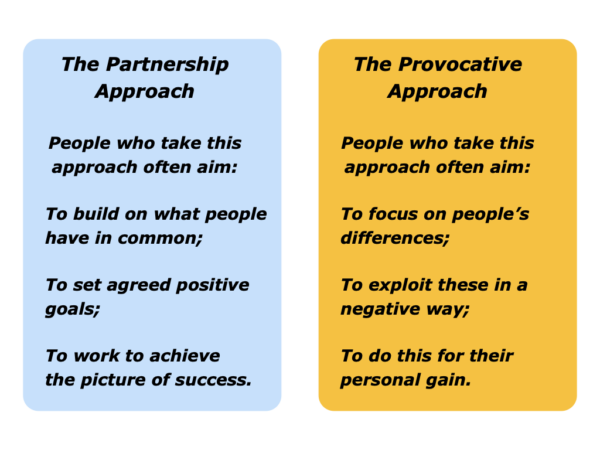
There are many ways to live life. Some people aim to follow the partnership approach. Some people follow the provocative approach. The route they follow has consequences for themselves and other people.
Different people follow these routes in different ways. Let’s explore how they may translate these into action.
The Partnership Approach
People who follow this approach often have a positive attitude. They do things that give them positive energy and also like to encourage other people.
They sometimes like to work as individuals. They may aim to build on their strengths and follow strategies that work. They then do their best to achieve success.
Such people also sometimes like to build partnerships with others. Different people do this in different ways. Some explore the following questions.
What are the partnerships I would like to build in my life? Who are the individuals, work colleagues, teams or organisations with whom I would like to build partnerships?
How can I build these partnerships in my personal or professional life? What may be the mutual benefits? When do I want to build these partnerships?
Imagine that a person has explored these themes. They may then take the following steps.
They Build On What
People Have In Common
Different people have different approaches to building partnerships. The way they do this may differ, of course, depending on whether they are doing it in their personal or professional life.
Some people borrow ideas from mediators who help people to build successful partnerships. They aim: a) to focus on what each party wants; b) to clarify some of the goals they have in common; c) to build on this common ground.
People who do this in personal relationships may start by focusing on what both they and the other person wants. They may then clarify the possibilities for building the relationship.
People who do this in professional relationships may start by clarifying what they would like to do in such a relationship. Let’s look at how this may work in practice.
Imagine that you are helping a group of individuals or teams to work together. The ideal scenario would be that they are already committed to working towards achieving a common goal. You can then help them to coordinate their talents to achieve the picture of success.
Let’s assume, however, that the parties are still in the process of clarifying their potential aims. One approach is to do some prework before bringing people together. You can start by aiming:
To use your imagination and put yourself in their places;
To think about what each party – each person or each team – wants to achieve in the future;
To consider whether there may be some potential common ground.
The next step will be to meet with each of the parties. Sometimes it can be important to have individual meetings with each of them before bringing people together.
Good mediators, for example, often take this approach. They find that this helps: a) to create a safe and non-judgemental environment in which people are able to explore; b) to clarify what each party’s wants.
Such mediators then take time to reflect. They clarify what each of the parties want and what each may have in common. They then begin to clarify the possible areas for cooperating and getting some quick successes.
Some people do the following exercise when clarifying what different individuals or teams want. You can also adapt this approach when clarifying the common ground in a personal or professional relationship.
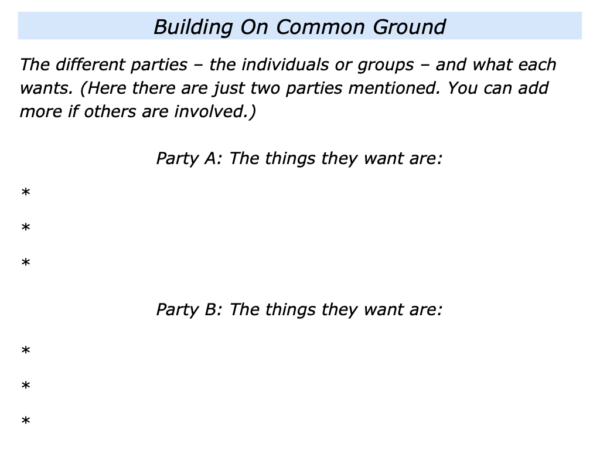
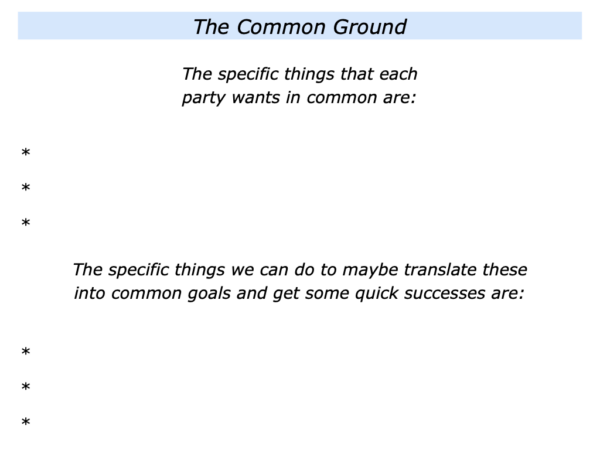
Let’s assume that a person has taken some of these steps to clarify the potential common ground. They may be doing this in their personal or professional life. They then move on to the next stage.
They Set Agreed Positive Goals
Some people follow the approach taken by good mediators. They create an encouraging environment, gather the parties involved and then take the following steps.
They focus on the areas
that people have in common
Good mediators create a positive atmosphere, show respect to people and describe some of the areas that people have in common. They explain that it may be possible to build on these areas and get some successes.
They also emphasise, however, that it is up to people to choose whether they want to take this route. If so, it may be possible build a successful partnership where there may be mutual benefits.
They set agreed positive goals
Let’s assume that a person has worked with others to focus on what they have in common. They may then encourage the parties to go through the following steps:
To focus on the common aims that are the easiest to achieve and to translate these into setting positive goals;
To clarify the benefits – for all the parties involved – of achieving these agreed positive goals.
To clarify the things that people can do – such as the strategies they can follow – to increase the likelihood of achieving the agreed positive goals.
Imagine that people have taken these steps. They can then aim to focus on the specific things they can do to get some quick successes. Successes can help to build confidence and encourage people to take the next step in building the partnership.
They Work To Achieve
The Picture Of Success
Let’s assume that the various parties have focused on their positive goals. They may then aim to coordinate their strengths to work together towards achieving this picture of success.
Different people will do this in different situations. Let’s look at some examples, beginning with personal relationships.
Personal Relationships
People who are in a committed romantic relationship or marriage, for example, may set some long-term goals. They may aim to encourage each other, build a family and live fulfilling lives.
Healthy couples, for example, often focus on the themes of affection, acceptance and adventure.
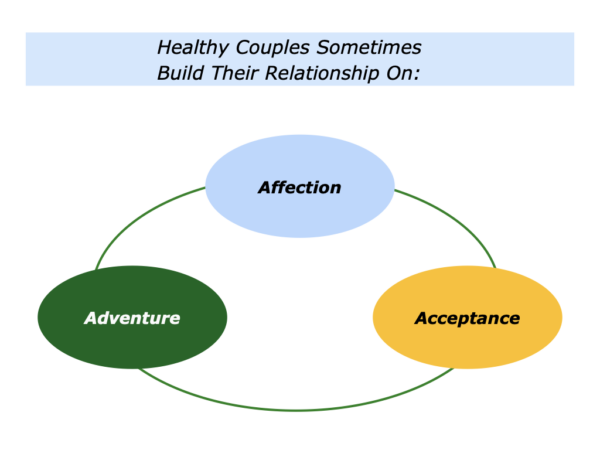
Affection
They show each other affection. Some may do this in a physical way. Some may do it in a psychological way.
They may show affection by making the other person feel welcome and helping them to feel the centre of their world. They may do it in simple ways, such as making them a cup of team, listening and encouraging them.
Acceptance
They build on the things they have in common. They also find ways to encourage and, in some case, manage any differences. They recognise that differences can make or break a relationship.
Healthy couples accept each other rather than constantly try to change each other. They realise that, after a certain time, people do not change all that much. They are clear on:
The differences they want to encourage, because these make the other person special;
The differences they are prepared to accept, because the person probably won’t change certain habits;
The differences they would like the person to change and how. It is vital for them to give a positive alternative.
Regarding the latter differences, they may suggest how they would like the person to behave in the future. But what if the person refuses to change? The person making the suggestion has a decision to make.
They can recognise that the other person is not going to change and accept the difference. They can keep trying to persuade the person to change. They can, if they feel the difference is too painful, choose to leave the relationship because there is no point in being a victim.
Adventure
Healthy couples share adventures together. These can be big adventures or even simply enjoying small talk together. They feel uplifted after their time together.
They may then individually go apart and pursue their own interests and adventures. This are ones that help them to feel alive but that do cause pain in the relationship.
The couple may then come back together to share what they have each been doing. They then build on what they have in common and share adventures. Sometimes this is simply chatting but in a positive way.
Such couples aim to enjoy their time together and also when they are apart. They take this approach to building an enriching relationship.
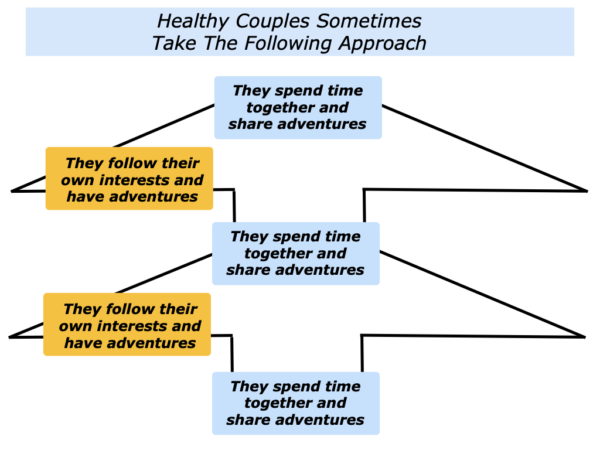
Different people follow these principles in their own way to build different kinds of personal relationships. Let’s look at how people may achieve their aims in professional relationships.
Professional Relationships
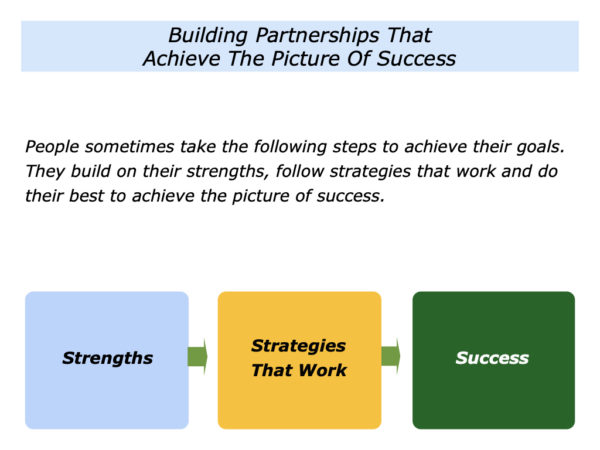
People who build professional partnerships may follow some of the well-known principles for working towards their agreed positive goals. They take the following approach.
They build on their strengths
They encourage each party to build on their strengths. They then make clear contracts about each person’s their best contribution towards achieving the goals.
They follow strategies that work
They coordinate their strengths and follow strategies that work. They continue to give each other support and focus on continuous improvement.
They do their best to
achieve the picture of success
They do what they say they are going to do, encourage each other and find solutions to challenges. They fulfil their contracts and do their best to achieve the agreed picture of success.
There are many ways to do fine work. Some people follow the partnerships approach. They aim to, as far as possible, get win-wins that benefit all the par
Such people believe in following the together approach rather than the tribal approach. Other people take the latter approach. Let’s look at this route.
The Provocative Approach
Some people follow the provocative approach. They focus on people’s differences and exploit these for their own personal gain. There are several definitions for the word provocative. These include the following:
Intending to do or say something that provokes a reaction such as an argument, anger or annoyance.
People who take this approach may do so in ways that hurt others and scapegoat people who are different. This can cause collateral damage and fracture society.
Let’s return to your own life and work. Looking ahead, can you think of a situation where you may want to follow elements of this approach? How can you do this in your own way?
How can you build on what people may have in common? How can you set agreed positive goals? How can you then do your best to help the people involved to achieve success?
If you wish, try tackling the exercise on this theme. This invites you to complete the following sentences.
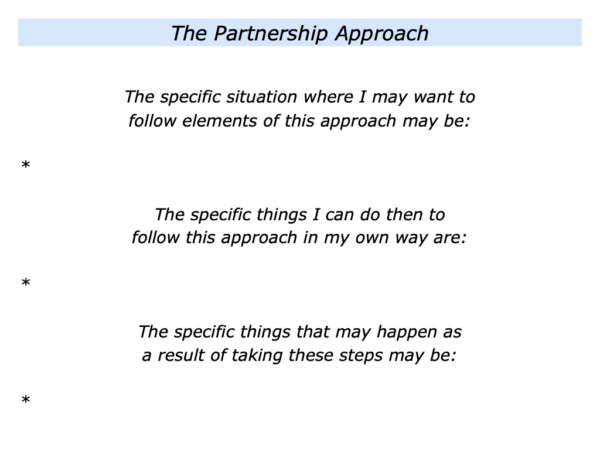


Leave a Reply